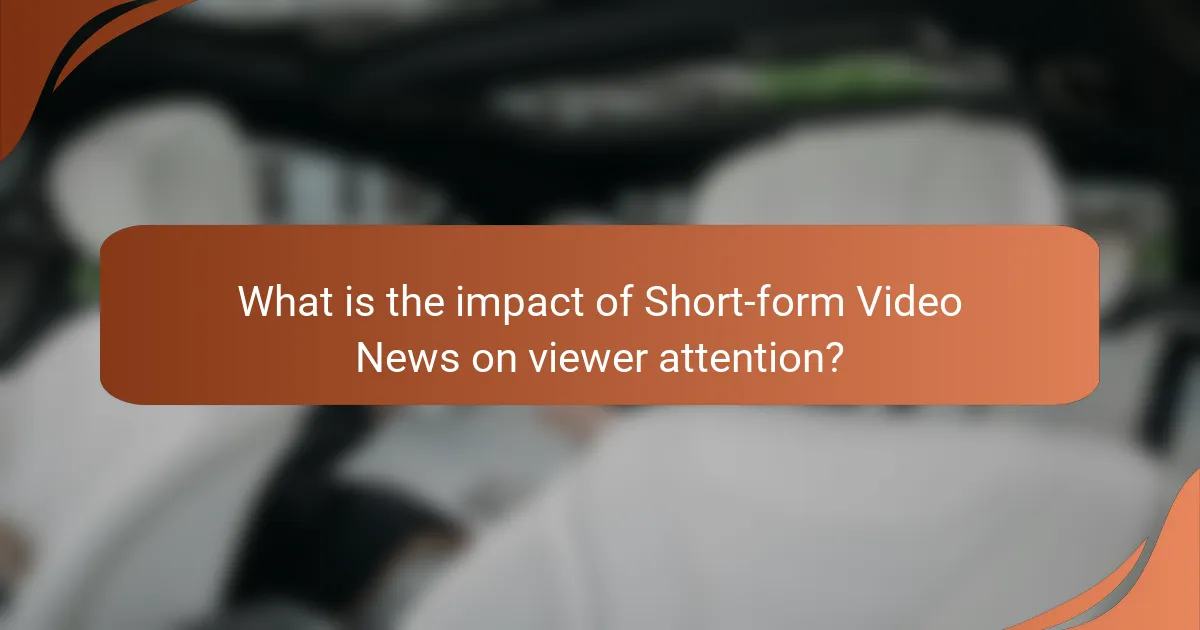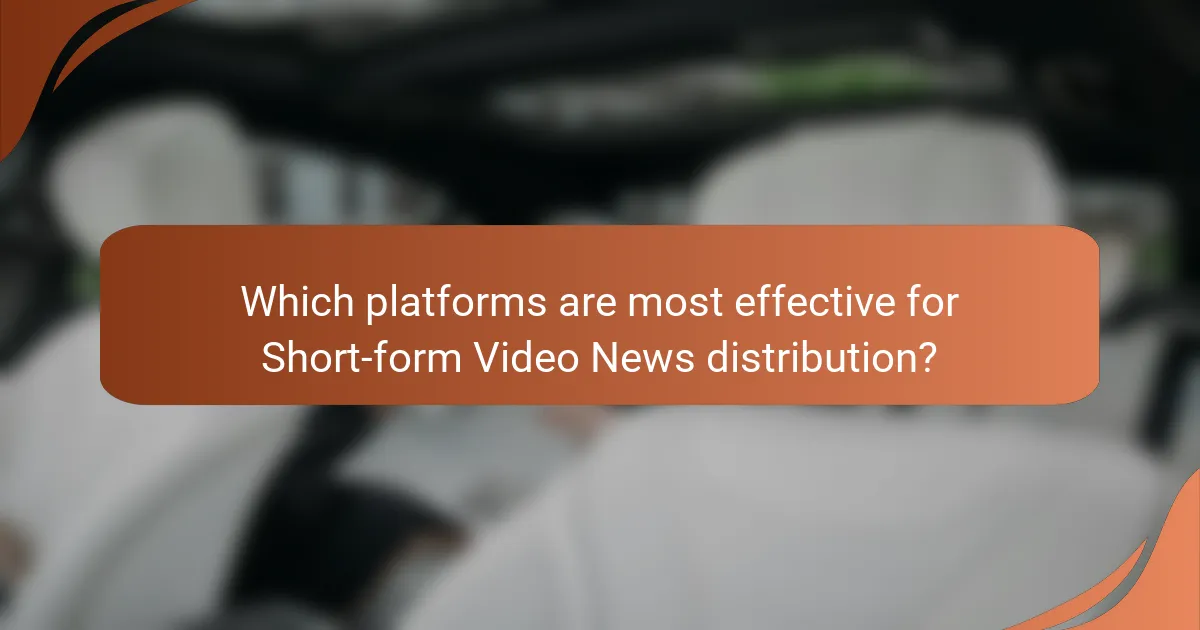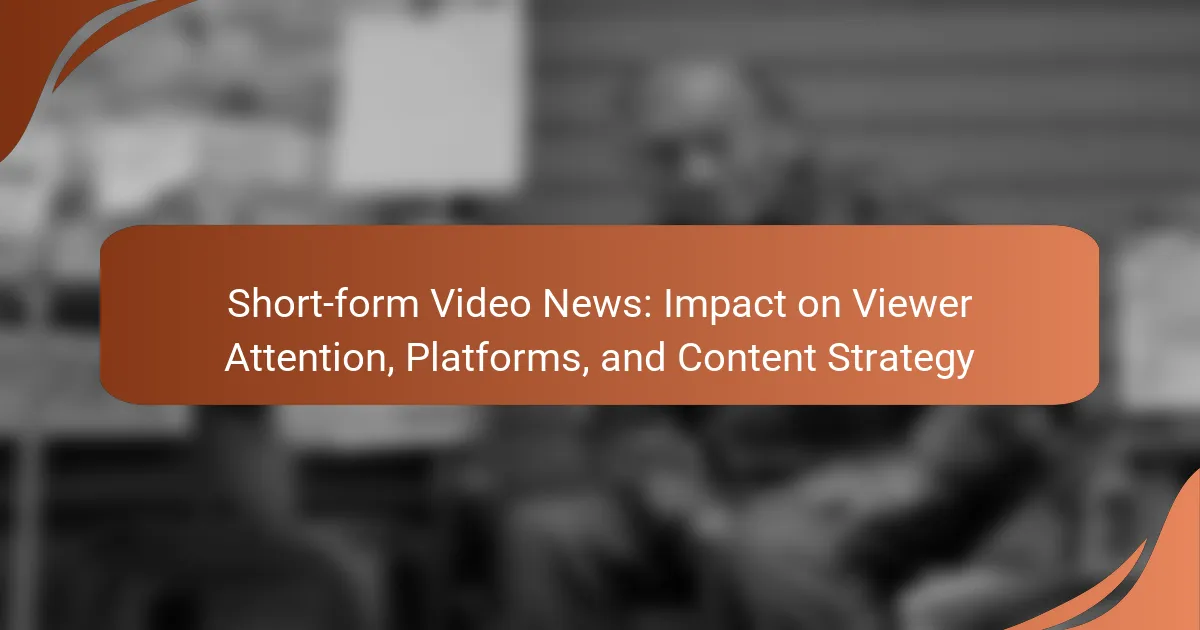Short-form video news is a concise news delivery format lasting under one minute, primarily distributed through social media platforms such as TikTok, Instagram Reels, and YouTube Shorts. This format caters to declining attention spans, with research indicating that 70% of viewers prefer brief news clips for their convenience and immediacy. Short-form videos enhance viewer retention and engagement, often leading to higher interaction rates compared to traditional media. The rise of mobile devices has further amplified the demand for quick, digestible news content, making short-form video news a critical component of modern content strategy.

What is Short-form Video News?
Short-form video news is a concise format for delivering news content, typically lasting less than one minute. This format is designed for quick consumption and often utilizes platforms like social media for distribution. Short-form video news engages viewers by presenting essential information rapidly. It caters to the declining attention spans of audiences. Research indicates that viewers prefer bite-sized content for its convenience and immediacy. The rise of mobile devices has further fueled the popularity of this format. Studies show that short-form videos can enhance viewer retention compared to longer news segments.
How has Short-form Video News evolved over time?
Short-form video news has evolved significantly over the past decade. Initially, it emerged with platforms like Vine and Instagram, which limited video length to encourage quick consumption. As mobile usage increased, news organizations recognized the need for concise, engaging content. The rise of TikTok in 2016 further popularized short-form videos, emphasizing creativity and immediacy. In response, traditional media adapted by creating their own short-form segments. Research indicates that audiences prefer brief news updates, leading to changes in content strategy. According to a 2021 Pew Research study, 53% of U.S. adults now consume news through social media platforms. This shift has prompted news outlets to prioritize visual storytelling and audience engagement in their short-form video content.
What technological advancements have influenced Short-form Video News?
Technological advancements such as mobile devices, high-speed internet, and social media platforms have significantly influenced short-form video news. Mobile devices enable users to access video content anytime and anywhere. High-speed internet facilitates quick streaming and downloading of videos. Social media platforms like TikTok and Instagram prioritize short-form content, driving its popularity. Advanced editing tools allow creators to produce engaging videos quickly. Artificial intelligence enhances content personalization and distribution strategies. These advancements collectively shape how news is consumed and produced in short formats.
How do cultural shifts impact the creation of Short-form Video News?
Cultural shifts significantly influence the creation of short-form video news. These shifts affect audience preferences and content consumption habits. For instance, the rise of social media has changed how news is delivered and consumed. Audiences now prefer quick, engaging content over lengthy articles. This demand drives news organizations to adapt their strategies. They focus on creating concise, visually appealing videos. Cultural trends also dictate the topics that gain traction. Issues like social justice or climate change can lead to increased viewership. Research indicates that platforms like TikTok and Instagram have transformed news dissemination. As a result, news creators must stay attuned to cultural dynamics. This responsiveness ensures relevance and audience engagement in a fast-paced media landscape.
What are the key characteristics of Short-form Video News?
Short-form video news is characterized by brevity, typically lasting under two minutes. It focuses on delivering concise information quickly. The format is designed for mobile consumption, catering to audiences with limited attention spans. Visual elements are prominent, enhancing engagement and understanding. It often includes dynamic editing and graphics to maintain viewer interest. Short-form video news is commonly distributed on social media platforms, maximizing reach. The content is timely, addressing current events and trending topics. This format appeals to younger demographics who prefer quick, digestible news.
How does the length of content affect viewer engagement?
Content length significantly impacts viewer engagement. Shorter content tends to retain viewers better than longer formats. Research shows that videos under two minutes have higher completion rates. For instance, a study by Wistia found that videos under 30 seconds had an 80% completion rate. In contrast, videos over two minutes saw a steep drop in viewer retention. This trend highlights the importance of concise messaging in short-form video news. Engaging content should prioritize brevity to maintain viewer attention effectively.
What formats are commonly used in Short-form Video News?
Common formats used in short-form video news include news briefs, social media stories, and live updates. News briefs are concise summaries of current events, typically lasting 30 seconds to 1 minute. Social media stories are engaging clips designed for platforms like Instagram and Snapchat, often featuring visuals and quick facts. Live updates provide real-time coverage of breaking news, allowing immediate viewer engagement. These formats cater to the fast-paced consumption habits of audiences today, emphasizing brevity and clarity in communication.

What is the impact of Short-form Video News on viewer attention?
Short-form video news significantly enhances viewer attention. Research indicates that shorter content retains viewers better than longer formats. A study by the Pew Research Center found that 70% of viewers prefer brief news clips. These clips often deliver concise information quickly, aligning with modern consumption habits. Additionally, platforms like TikTok and Instagram have capitalized on this trend, increasing engagement rates. Short-form videos cater to shorter attention spans, with average engagement times dropping to under 10 seconds for traditional media. This format encourages repeat views and shares, further amplifying reach and impact.
How does Short-form Video News capture and maintain viewer attention?
Short-form video news captures and maintains viewer attention through concise storytelling and engaging visuals. These videos typically last under two minutes, catering to the short attention spans of modern audiences. By delivering information quickly, they prevent viewer fatigue. High-quality visuals and dynamic editing enhance engagement. Platforms like TikTok and Instagram prioritize such content, driving higher viewership. Research indicates that 85% of viewers prefer short videos for news over longer formats. This preference is supported by the need for instant information in a fast-paced digital environment.
What psychological factors influence viewer engagement with Short-form Video News?
Viewer engagement with short-form video news is influenced by several psychological factors. One key factor is attention span. Research indicates that shorter content aligns with the decreased attention spans of viewers. This aligns with findings from the National Center for Biotechnology Information, which states that average attention span has declined significantly in recent years.
Another factor is emotional appeal. Content that evokes strong emotions tends to be more engaging. According to a study published in the Journal of Communication, emotionally charged stories lead to higher viewer retention.
Social validation also plays a role. Viewers are influenced by social media trends and peer recommendations. The influence of social proof can enhance engagement, as noted in research by Cialdini, which highlights the impact of social influence on decision-making.
Lastly, personalization enhances viewer connection. Tailored content that resonates with individual interests increases engagement. A study from the Journal of Advertising Research supports this, showing that personalized content leads to higher viewer interaction rates.
How do visuals and audio contribute to viewer retention?
Visuals and audio significantly enhance viewer retention by engaging multiple senses. Engaging visuals capture attention and provide context, making information easier to understand. Studies show that people remember 80% of what they see and only 20% of what they read. Audio elements, such as voiceovers and sound effects, create emotional connections, which increase memorability. Research indicates that audio-visual content leads to a 65% retention rate compared to 10% for text-only formats. Together, these elements create a more immersive experience. This immersive quality keeps viewers interested and encourages them to watch longer.
What demographic factors affect viewer attention to Short-form Video News?
Age, gender, education level, and socioeconomic status significantly affect viewer attention to short-form video news. Younger audiences, particularly those aged 18-34, show higher engagement levels. This demographic often prefers quick, digestible content. Gender differences also play a role, with studies indicating that women may engage differently than men. Education level influences the type of content consumed and attention span. Socioeconomic status can determine access to technology and platforms, impacting viewer engagement. Research from the Pew Research Center highlights these demographic trends in media consumption.
How do age groups respond differently to Short-form Video News?
Younger age groups tend to engage more with short-form video news compared to older age groups. Studies indicate that individuals aged 18-24 are more likely to consume news through platforms like TikTok and Instagram. This demographic prefers quick, digestible content that aligns with their fast-paced consumption habits. In contrast, older age groups, such as those aged 50 and above, often favor traditional news formats. They may find short-form videos less informative and prefer longer, detailed reports. Research from the Pew Research Center shows that 63% of younger adults use social media for news, while only 25% of older adults do the same. This disparity highlights differing preferences in content delivery and consumption methods across age groups.
What role does social media play in attracting diverse audiences?
Social media plays a crucial role in attracting diverse audiences. It allows for targeted content distribution based on user preferences and demographics. Platforms like Instagram, TikTok, and Twitter enable brands to engage with various cultural groups effectively. The visual nature of short-form video content appeals to younger audiences, enhancing reach. According to a Pew Research Center study, 69% of U.S. adults use social media, creating a vast pool of potential viewers. This diverse user base encourages brands to tailor their messaging, fostering inclusivity. Engaging content can go viral, further expanding audience reach across different communities.

Which platforms are most effective for Short-form Video News distribution?
TikTok, Instagram Reels, and YouTube Shorts are the most effective platforms for short-form video news distribution. TikTok leads with its algorithm that promotes engaging content to a wide audience. Instagram Reels benefits from its integration with existing social media networks, enhancing shareability. YouTube Shorts leverages the extensive user base of YouTube, providing significant reach. Research indicates that TikTok users spend an average of 52 minutes daily on the app, showcasing its potential for news consumption. Additionally, Instagram has over 1 billion active users, increasing the likelihood of news visibility. These platforms cater to the growing demand for quick, digestible news content.
What are the leading platforms for Short-form Video News?
The leading platforms for short-form video news include TikTok, Instagram Reels, YouTube Shorts, and Snapchat. TikTok has rapidly gained popularity due to its algorithm that promotes engaging content. Instagram Reels allows users to create and share 15 to 60-second videos, integrating seamlessly with existing Instagram content. YouTube Shorts offers creators a way to produce short videos, leveraging YouTube’s extensive audience. Snapchat provides ephemeral video content, appealing to a younger demographic. These platforms have transformed how news is consumed, emphasizing quick, visual storytelling.
How do platform algorithms impact the visibility of Short-form Video News?
Platform algorithms significantly influence the visibility of Short-form Video News. These algorithms determine how content is ranked and displayed to users. They analyze user engagement metrics, such as watch time and likes, to prioritize videos. Higher engagement leads to increased visibility on feeds and recommendation sections. Algorithms also consider relevancy to user interests and trending topics. This means that timely and relevant Short-form Video News is more likely to be promoted. For example, platforms like TikTok and Instagram use sophisticated algorithms to surface popular content. Research shows that videos with higher engagement rates can achieve up to 70% more views. Thus, understanding platform algorithms is crucial for maximizing the reach of Short-form Video News.
What unique features do different platforms offer for Short-form Video News creators?
TikTok offers advanced algorithm-driven content discovery, enabling creators to reach targeted audiences effectively. Instagram Reels provides integrated editing tools and the ability to share content on Stories, enhancing visibility. YouTube Shorts allows monetization options through ad revenue, incentivizing creators for their content. Snapchat Spotlight features a unique submission process that rewards popular videos with monetary compensation. Twitter Fleets enables quick, ephemeral content sharing, fostering real-time engagement. Each platform’s distinct features cater to varying creator needs and audience interactions.
How should content strategy adapt to various platforms?
Content strategy should adapt to various platforms by tailoring content formats and messaging. Each platform has unique audience behaviors and preferences. For instance, short-form videos thrive on platforms like TikTok and Instagram. These formats capture attention quickly and engage viewers effectively. In contrast, longer articles may perform better on platforms like LinkedIn. Here, audiences expect in-depth analysis and detailed information.
Additionally, content should align with platform algorithms to enhance visibility. For example, Facebook prioritizes video content, while Twitter favors concise text updates. Understanding these nuances is critical for maximizing reach. Analytics can guide adjustments based on performance metrics across platforms. Adapting content strategy ensures relevance and engagement with diverse audiences.
What best practices should be followed for creating platform-specific Short-form Video News?
Create engaging content tailored to each platform’s audience. Use concise storytelling to capture attention quickly. Optimize video length according to platform preferences. For example, TikTok favors videos under 60 seconds, while Instagram Reels supports up to 90 seconds. Incorporate platform-specific features, such as hashtags and music, to enhance visibility. Utilize eye-catching thumbnails to encourage clicks. Ensure captions are included for accessibility and engagement. Analyze performance metrics regularly to refine strategies. Adapting content based on viewer feedback improves relevance and reach.
How can analytics inform content strategy for Short-form Video News?
Analytics can inform content strategy for Short-form Video News by providing insights into viewer engagement and preferences. Data on viewer retention rates indicates which segments of videos hold attention. Metrics like click-through rates reveal which headlines attract viewers. Audience demographics help tailor content to specific groups. Performance analysis can identify optimal posting times for maximum reach. A/B testing different video formats can optimize content delivery. Tracking social shares and comments provides feedback on audience sentiment. These insights can guide the creation of more relevant and impactful short-form news content.
What are the best practices for creating engaging Short-form Video News?
To create engaging short-form video news, focus on clear storytelling and concise messaging. Begin with a strong hook to capture viewer attention within the first few seconds. Use high-quality visuals and sound to enhance engagement. Incorporate subtitles, as many viewers watch without sound. Keep videos under 60 seconds to maintain viewer interest. Utilize trending topics and hashtags to increase discoverability. Engage with your audience by asking questions or prompting comments. Analyze viewer metrics to refine content strategy based on audience preferences. Research shows that videos shorter than one minute have a higher completion rate, emphasizing the importance of brevity.
Short-form video news is a concise news delivery format lasting under one minute, tailored for quick consumption on social media platforms. This article explores its evolution, technological influences, and cultural shifts that shape viewer engagement. It highlights key characteristics, such as brevity and visual appeal, and examines how demographics affect attention to this content. Additionally, it discusses the role of platform algorithms and best practices for creating effective short-form news, emphasizing the importance of analytics in refining content strategies.
